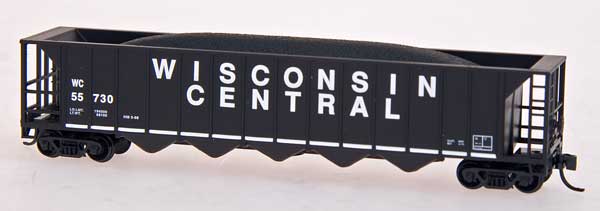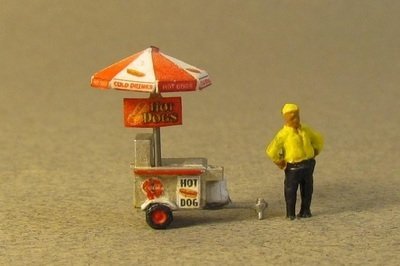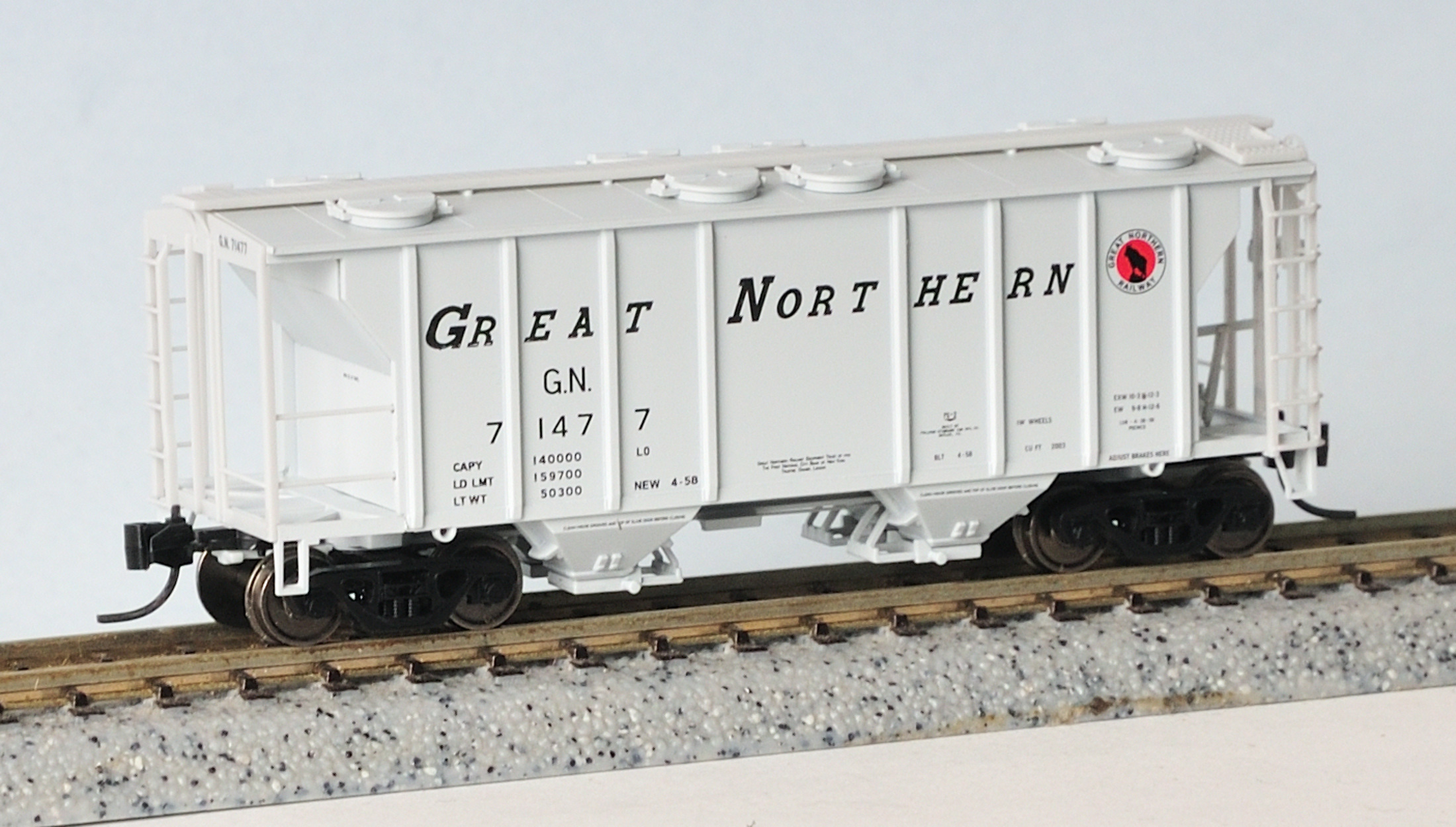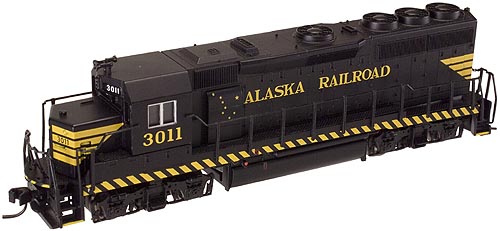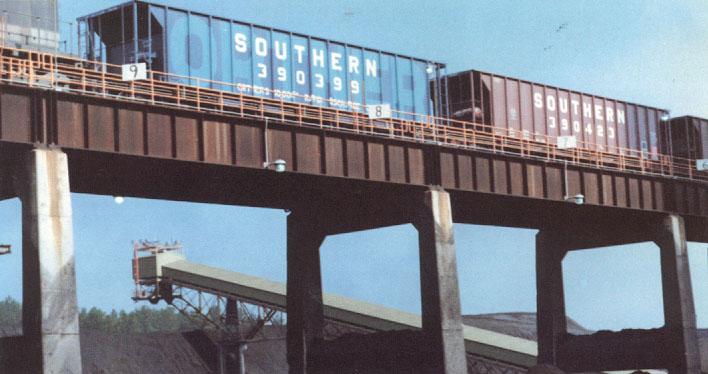Model Information: Precision Master first released this body style in kit form in 1986. Later on, they released the same body as a RTR (Ready-to-Run) model. In 2005, Red Caboose acquired this tooling from PM. Red Caboose has released this model in RTR form. When Red Caboose folded its doors, Fox Valley acquired the tooling and produced releases with the Fox Valley brand.
Different releases had some fairly important differences. Some Red Caboose releases have their coal loads permanently glued in place. This is a shame because the loads are pretty cheesy and if they are permanently affixed, then they cannot be replaced by high quality third party loads such as are made by Hay Brothers. Trucks and couplers vary as well. Early Red Caboose releases feature Micro-Trains trucks and couplers with MT's "standard" wheels. Later Red Caboose releases use cheaper Chinese knock-offs of the MT trucks (to save a few $ we assume). Fox Valley versions have body-mounted (MTL-knockoff) couplers using the new adapter designed by Trainworx.
These models are overall pretty good with a typical 1980s level of detail in the molding. The printing on all the manufacturers' models is quite good. However, the underframe is so awful it looks almost MELTED. Flipping it over and comparing it side-by-side with a 1960s vintage Roco-made hopper really shows off what a complete mess the underside of this car is. The Roco hopper is not just a little, but a LOT superior in terms if the molding. Also, let us be clear, for the models that include loads, these included loads are only a small step up from trash. An early 1960s coal load from an Arnold car looks better! If you are going to run these, make sure you only buy ones that do not have their loads glued in and be prepared to shell out some cash for a Hay Brothers (or equivalent) high quality N Scale load.
Different releases had some fairly important differences. Some Red Caboose releases have their coal loads permanently glued in place. This is a shame because the loads are pretty cheesy and if they are permanently affixed, then they cannot be replaced by high quality third party loads such as are made by Hay Brothers. Trucks and couplers vary as well. Early Red Caboose releases feature Micro-Trains trucks and couplers with MT's "standard" wheels. Later Red Caboose releases use cheaper Chinese knock-offs of the MT trucks (to save a few $ we assume). Fox Valley versions have body-mounted (MTL-knockoff) couplers using the new adapter designed by Trainworx.
These models are overall pretty good with a typical 1980s level of detail in the molding. The printing on all the manufacturers' models is quite good. However, the underframe is so awful it looks almost MELTED. Flipping it over and comparing it side-by-side with a 1960s vintage Roco-made hopper really shows off what a complete mess the underside of this car is. The Roco hopper is not just a little, but a LOT superior in terms if the molding. Also, let us be clear, for the models that include loads, these included loads are only a small step up from trash. An early 1960s coal load from an Arnold car looks better! If you are going to run these, make sure you only buy ones that do not have their loads glued in and be prepared to shell out some cash for a Hay Brothers (or equivalent) high quality N Scale load.
Prototype History: The 1960s brought about a growth in car size (and capacity). Railroads that transported coal moved away from the older 2-bay 55-ton USRA standard to newer railcars. The Ortner Rapid discharge car has a capacity of 100 tons. Over 10,000 cars of this kind were produced. Robert Ortner and a team of engineers created the rapid-discharge door system in the early 1960s. The original unit train consists were operating for Muskingum Electric Railroad (now AEP) and the Missouri Public Service Co.
Unloading a train of rapid discharge cars takes 30 minutes to an hour as opposed to four hours or longer for other unloading systems. Southern developed the unit train concept in 1960. Unit trains shuttle back and forth between mines and power plants. The first unit trains, composed of aluminum gondolas, went to power plants with rotary dumping facilities. Today, Southern has 14 unit coal trains on line; six in immediate prospect; and several others in longer range planning. While passing over a 900-foot long trestle, rapid discharge cars unload their coal in motion. Doors in the bottom of the cars are activated electrically.
Trinity Industries Inc. purchased Ortner Freight Car in late 1986 and continues to develop the rapid-discharge system with both updated transverse and longitudinal door applications. Trinity currently offers aluminum hoppers featuring the RDVI and RDL door systems.
Unloading a train of rapid discharge cars takes 30 minutes to an hour as opposed to four hours or longer for other unloading systems. Southern developed the unit train concept in 1960. Unit trains shuttle back and forth between mines and power plants. The first unit trains, composed of aluminum gondolas, went to power plants with rotary dumping facilities. Today, Southern has 14 unit coal trains on line; six in immediate prospect; and several others in longer range planning. While passing over a 900-foot long trestle, rapid discharge cars unload their coal in motion. Doors in the bottom of the cars are activated electrically.
Trinity Industries Inc. purchased Ortner Freight Car in late 1986 and continues to develop the rapid-discharge system with both updated transverse and longitudinal door applications. Trinity currently offers aluminum hoppers featuring the RDVI and RDL door systems.
Road Name History: 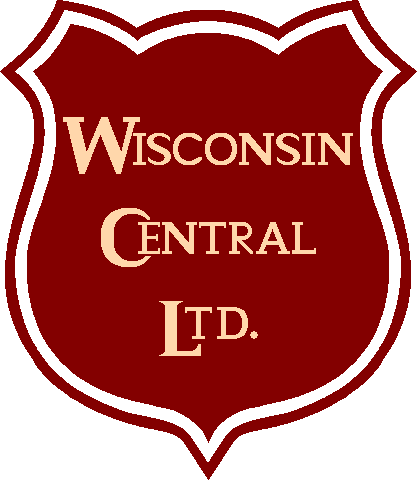 Wisconsin Central Ltd. (reporting mark WC) is a railroad subsidiary of the Canadian National Railway. At one time, its parent Wisconsin Central Transportation Corporation owned or operated railroads in the United States, Canada (Algoma Central Railway), the United Kingdom (English Welsh & Scottish), New Zealand (Tranz Rail), and Australia (Australian Transport Network).
Wisconsin Central Ltd. (reporting mark WC) is a railroad subsidiary of the Canadian National Railway. At one time, its parent Wisconsin Central Transportation Corporation owned or operated railroads in the United States, Canada (Algoma Central Railway), the United Kingdom (English Welsh & Scottish), New Zealand (Tranz Rail), and Australia (Australian Transport Network).
Wisconsin Central Ltd. (WC) started in US in the mid-1980s using most of the original Wisconsin Central Railway's rights of way and some former Milwaukee Road rights of way after the Soo Line Railroad acquired the Wisconsin, Illinois, Indiana, Missouri and Minnesota holdings of the bankrupt Milwaukee Road and divested its older railway trackage in Wisconsin. In 1993 the Wisconsin Central also acquired the Green Bay and Western Railroad and the Fox River Valley Railroad.
At the time of its sale to Canadian National, Wisconsin Central operated over 2,850 miles (4,590 km) of track in the Great Lakes region. The railroad extended from Chicago into and through Wisconsin to Minneapolis/St. Paul and Duluth, Minnesota, to Sault Ste Marie, Michigan, and north (through the Algoma Central Railway) to Hearst, Ontario.
A condition of Soo Line’s acquisition of Milwaukee Road was that they had to sell a number of lines in Wisconsin and Michigan’s Upper Peninsula. They established Lake States Transportation to separate these lines from the rest of Soo Line. In 1987, Lake States was sold to a group of investors and Wisconsin Central was born. Much of the track had belonged to the original Wisconsin Central, a Soo subsidiary which had been merged into Soo in 1960. In 1993, WC acquired Fox River Valley Railroad and Green Bay & Western. In 1995, they founded a Canadian subsidiary and acquired the Algoma Central. Then in 1997, they picked up another 200 miles of former C&NW line running north from Green Bay from Union Pacific. At this point, the 2,850 mile WC (between GM&O and Erie Lackawanna in relative size) linked: Chicago, Milwaukee, Green Bay, Minneapolis/St.Paul, Duluth/Superior, then down Michigan’s Upper Peninsula to Sault Ste. Marie where they connected to Algoma Central north to Hearst, Ontario. WC’s parent company also went on a buying spree of railroads in other countries including New Zealand, Britain, and Australia. Wisconsin Central was sold to Canadian National in 2001. It operates as a paper railroad under CN’s flag today.
From Wikipedia and Bluford Shops

Wisconsin Central Ltd. (WC) started in US in the mid-1980s using most of the original Wisconsin Central Railway's rights of way and some former Milwaukee Road rights of way after the Soo Line Railroad acquired the Wisconsin, Illinois, Indiana, Missouri and Minnesota holdings of the bankrupt Milwaukee Road and divested its older railway trackage in Wisconsin. In 1993 the Wisconsin Central also acquired the Green Bay and Western Railroad and the Fox River Valley Railroad.
At the time of its sale to Canadian National, Wisconsin Central operated over 2,850 miles (4,590 km) of track in the Great Lakes region. The railroad extended from Chicago into and through Wisconsin to Minneapolis/St. Paul and Duluth, Minnesota, to Sault Ste Marie, Michigan, and north (through the Algoma Central Railway) to Hearst, Ontario.
A condition of Soo Line’s acquisition of Milwaukee Road was that they had to sell a number of lines in Wisconsin and Michigan’s Upper Peninsula. They established Lake States Transportation to separate these lines from the rest of Soo Line. In 1987, Lake States was sold to a group of investors and Wisconsin Central was born. Much of the track had belonged to the original Wisconsin Central, a Soo subsidiary which had been merged into Soo in 1960. In 1993, WC acquired Fox River Valley Railroad and Green Bay & Western. In 1995, they founded a Canadian subsidiary and acquired the Algoma Central. Then in 1997, they picked up another 200 miles of former C&NW line running north from Green Bay from Union Pacific. At this point, the 2,850 mile WC (between GM&O and Erie Lackawanna in relative size) linked: Chicago, Milwaukee, Green Bay, Minneapolis/St.Paul, Duluth/Superior, then down Michigan’s Upper Peninsula to Sault Ste. Marie where they connected to Algoma Central north to Hearst, Ontario. WC’s parent company also went on a buying spree of railroads in other countries including New Zealand, Britain, and Australia. Wisconsin Central was sold to Canadian National in 2001. It operates as a paper railroad under CN’s flag today.
From Wikipedia and Bluford Shops
Brand/Importer Information:  Originally Red Caboose was a manufacturer of HO and N Scale model railroading items. It was located in Mead, Colorado, and was founded in 1990 by Leon Fairbanks.
Red Caboose manufactured highly accurate, well detailed N, HO, and O Scale freight cars and locomotives.
Originally Red Caboose was a manufacturer of HO and N Scale model railroading items. It was located in Mead, Colorado, and was founded in 1990 by Leon Fairbanks.
Red Caboose manufactured highly accurate, well detailed N, HO, and O Scale freight cars and locomotives.
Red Caboose closed its doors in January of 2015. Red Caboose N Scale has been sold to Fox Valley Models and HO was sold to InterMountain Railway. Many of the Red Caboose toolings have seen re-releases from Fox Valley since the acquisition. We just wish they would clean up the underframes. Red Caboose always went light on the details where they thought people wouldn't look.

Red Caboose closed its doors in January of 2015. Red Caboose N Scale has been sold to Fox Valley Models and HO was sold to InterMountain Railway. Many of the Red Caboose toolings have seen re-releases from Fox Valley since the acquisition. We just wish they would clean up the underframes. Red Caboose always went light on the details where they thought people wouldn't look.
Manufacturer Information: While they were in business, Red Caboose split its production runs between the US and China. Which models were produced where was a function of which body style and which run. Furthermore, which Chinese company was used for production is something we would love to find out.
Item created by: gdm on 2017-03-05 07:32:27. Last edited by gdm on 2020-05-14 19:42:14
If you see errors or missing data in this entry, please feel free to log in and edit it. Anyone with a Gmail account can log in instantly.
If you see errors or missing data in this entry, please feel free to log in and edit it. Anyone with a Gmail account can log in instantly.


